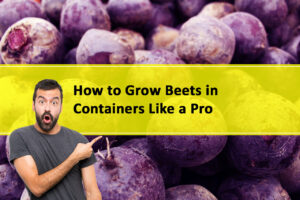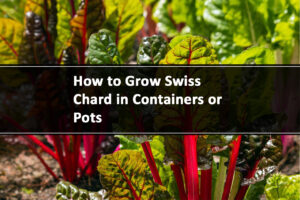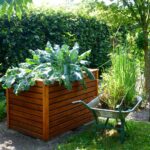Beautiful Plants For Your Interior
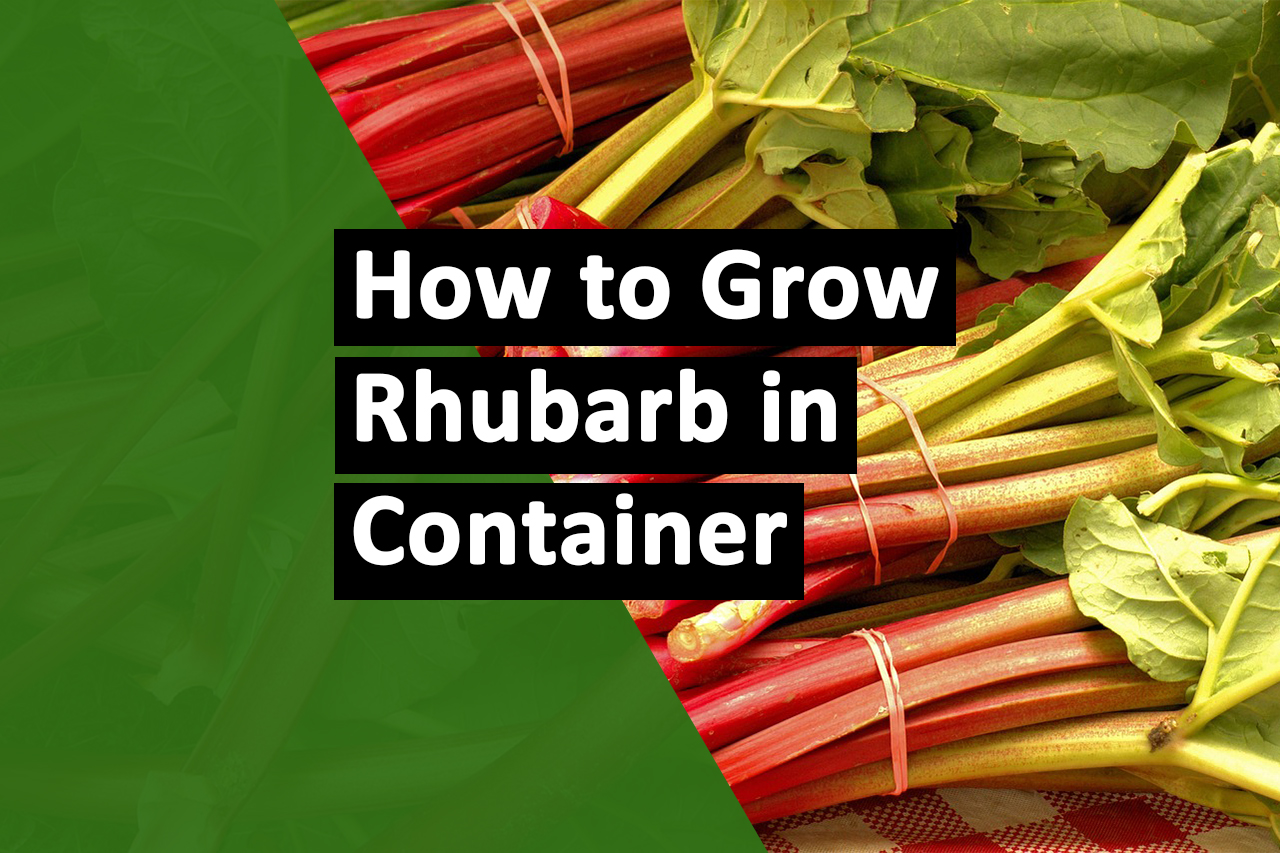
From Garden to Table: Growing Rhubarb in Containers Made Easy
Looking to grow rhubarb in containers? Rhubarb, with its tart and tangy flavor, is a versatile perennial vegetable that adds a unique touch to both sweet and savory dishes. Traditionally grown in large garden beds, rhubarb can also thrive in containers, making it an excellent option for urban gardeners or those with limited space.
In this comprehensive guide, we will explore the step-by-step process of successfully growing rhubarb in containers, from selecting the right variety and container to providing optimal growing conditions and caring for your plants.
About Rhubarb
Rhubarb is a tart, cool-season plant with edible stalks that are commonly used in cooking. The stalks, usually red or green, are harvested while the toxic leaves are avoided. Rhubarb is often sweetened and used in desserts like pies and jams, but it can also be used in savory dishes. It provides vitamins K and C, as well as dietary fiber. However, moderation is advised due to its oxalic acid content. Overall, rhubarb is a versatile ingredient adding a unique tang to various dishes.
How to Grow Rhubarb in Containers
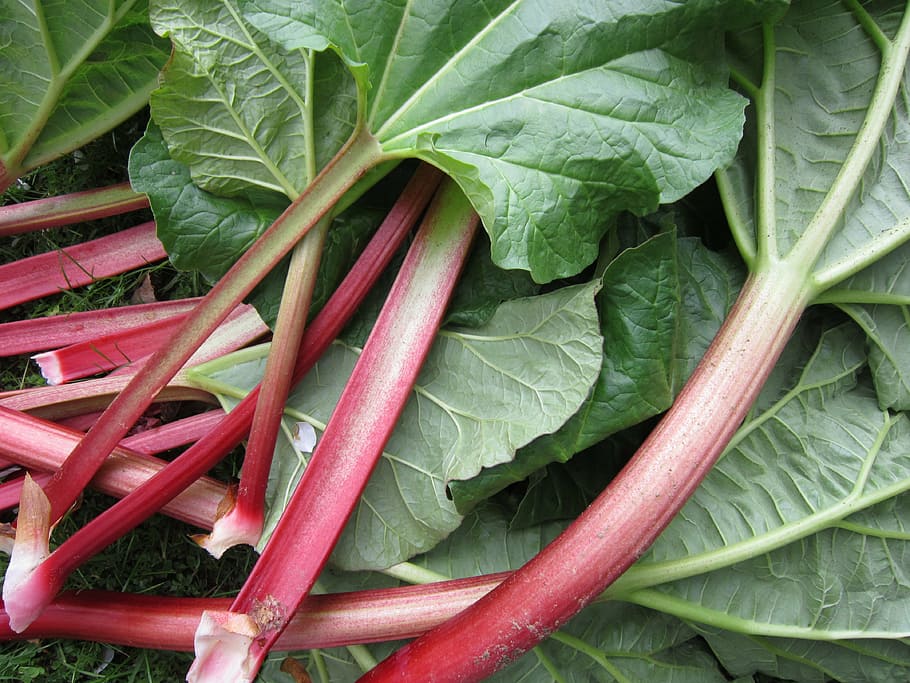
-
Choosing the Right Variety
The first step in growing rhubarb in containers is selecting the right variety. Here are a few popular rhubarb cultivars that are well-suited for container gardening:
a) Crimson Cherry: This variety produces vibrant red stalks with a sweet flavor.
b) Victoria: Known for its excellent yield, Victoria offers large green stalks with a pleasant tartness.
c) Raspberry Red: With its red and green mottled stalks, Raspberry Red is a visually appealing option that has a good balance of sweetness and tartness. -
Selecting the Container
Choosing the appropriate container is crucial for the success of your rhubarb plants. Here are some factors to consider:
a) Size and Depth: Opt for a container that is at least 12 to 16 inches deep and wide, providing ample space for the roots to grow.
b) Material: Select containers made of durable materials such as plastic, ceramic, or wood, ensuring proper drainage and insulation.
c) Number of Plants: Ideally, each container should accommodate one rhubarb plant to prevent overcrowding. -
Soil and Planting
Proper soil preparation and planting techniques are essential for healthy rhubarb growth. Follow these steps:
a) Soil Preparation: Use well-draining soil enriched with organic matter, such as compost or aged manure, to improve fertility and drainage.
b) pH Level: Rhubarb thrives in slightly acidic to neutral soil (pH 6.0-7.0). Test the soil using a pH testing kit and adjust if necessary.
c) Planting Process: Dig a hole deep enough to accommodate the root system of the rhubarb plant, ensuring the crown sits level with or slightly above the soil surface. Space multiple plants at least 3 feet apart to provide adequate room for growth. -
Watering and Fertilizing
Proper watering and regular fertilization are vital for the health and productivity of your rhubarb plants. Follow these guidelines:
a) Watering: Keep the soil consistently moist but not waterlogged. Water deeply when the top inch of the soil feels dry. Avoid overhead watering to prevent leaf diseases.
b) Fertilization: Apply a balanced, slow-release fertilizer or compost in early spring and again after harvesting. Avoid excessive nitrogen, as it can promote leafy growth at the expense of stalk production. -
Providing Optimal Growing Conditions
Creating the right growing conditions will ensure robust rhubarb plants. Consider the following factors:
a) Sunlight: Place your containers in a spot that receives at least six hours of direct sunlight per day. Rhubarb benefits from full sun but can tolerate partial shade.
b) Temperature and Climate: Rhubarb thrives in cool climates with temperatures between 40°F and 75°F (4°C and 24°C). Protect your plants from extreme heat or frost by moving the containers accordingly.
c) Wind Protection: Rhubarb plants can suffer from wind damage, so position them in a location sheltered from strong winds or use windbreaks. -
Maintenance and Harvesting
Regular maintenance and proper harvesting techniques will ensure the longevity and productivity of your rhubarb plants. Follow these tips:
a) Weed Control: Keep the area around your containers free from weeds to prevent competition for nutrients and moisture.
b) Mulching: Apply a layer of organic mulch, such as straw or wood chips, to conserve moisture, suppress weeds, and regulate soil temperature.
c) Harvesting: Wait until the second year after planting to harvest stalks. Gently pull or cut the stalks at the base when they reach a length of 10-15 inches. Always leave a few stalks to allow the plant to continue growing.
What is The Best Container to Grow Rhubarb in?
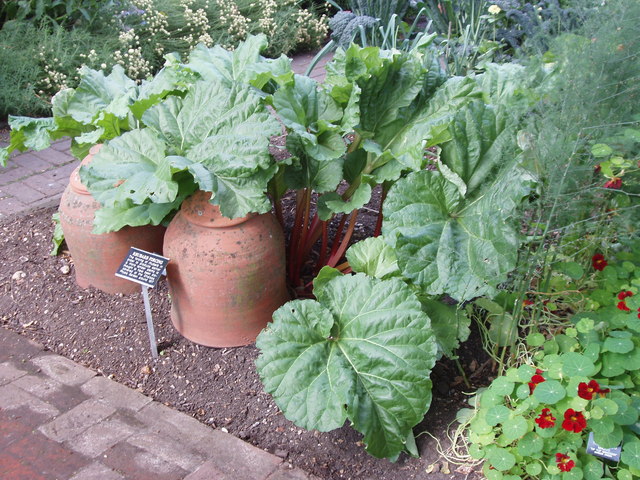
The best container for growing rhubarb is a large, deep container that can accommodate the plant’s extensive root system. A container with a minimum depth of 18 inches (45 cm) is recommended to allow the rhubarb roots to develop properly. It’s also important to choose a container that has good drainage to prevent waterlogging.
Opt for a container made of a durable material such as plastic, ceramic, or wood. Make sure it has drainage holes at the bottom to allow excess water to escape. This helps prevent root rot and other water-related issues.
Additionally, consider the size of the container. Rhubarb plants can grow quite large, so choose a container that provides enough space for the plant to spread out and develop.
How and When to Transplant Rhubarb in Containers
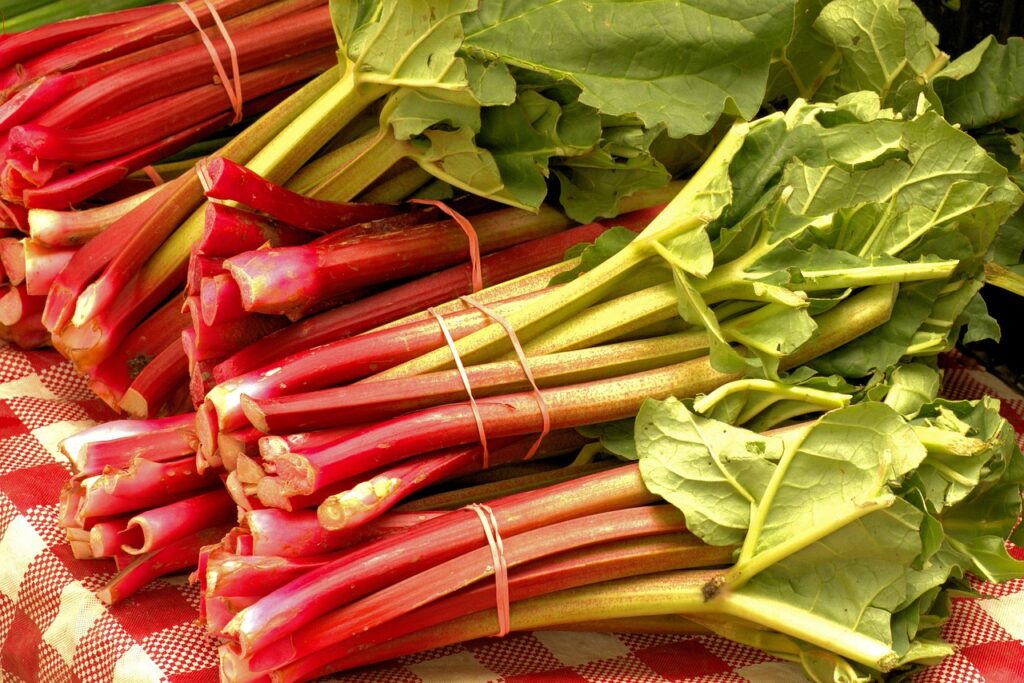
To transplant rhubarb in containers, follow these steps. With these steps and proper care, your rhubarb plant should adapt well to its new container environment and continue to grow and produce delicious stalks for you to enjoy:
Choose the right time: The ideal time to transplant rhubarb in containers is during early spring or late fall when the temperatures are cool. This allows the plant to establish its roots before the hot summer or freezing winter months.
Prepare the container: Select a large container that is at least 12 to 18 inches deep and has a capacity of 15 to 20 gallons. Ensure it has drainage holes to prevent waterlogging. Fill the container with a well-draining potting mix, leaving some space at the top for the rhubarb plant.
Prepare the rhubarb plant: Before transplanting, water the rhubarb plant thoroughly to ensure the roots are well hydrated. This makes it easier to remove the plant from its current location without damaging the roots.
Carefully remove the plant: Dig around the rhubarb plant, starting from the outer edge, to loosen the soil and expose the roots. Use a garden fork or shovel to lift the plant from the ground. Try to keep the root ball intact as much as possible.
Transplant into the container: Place the rhubarb plant in the prepared container, ensuring that the crown (the point where the roots meet the stem) is at or slightly above the soil level. Fill the container with the potting mix, gently firming the soil around the roots to eliminate air pockets.
Water thoroughly: After transplanting, water the rhubarb plant thoroughly to help settle the soil and ensure good root-to-soil contact. This will promote healthy growth and establishment.
Provide proper care: Place the container in a location that receives full sun to partial shade, and water the plant regularly to maintain moist but not waterlogged soil. Remember to fertilize the rhubarb plant with a balanced organic fertilizer or compost during the growing season.
What are Rhubarb growing problems in containers?
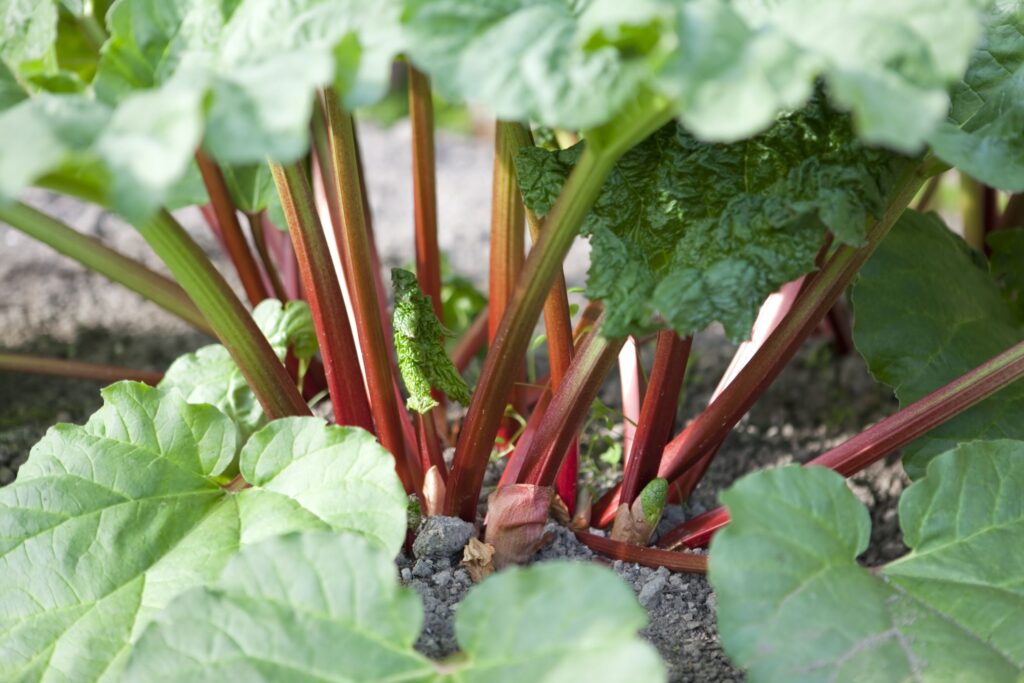
Growing rhubarb in containers can encounter a few common problems. Here are some potential issues you may face when growing rhubarb in containers:
Root crowding: Rhubarb plants have vigorous root systems, and when grown in containers, the roots can become crowded over time. This can lead to stunted growth and reduced yields. To address this, consider dividing and repotting the plant into a larger container every few years.
Insufficient space: Containers may limit the amount of space available for the rhubarb plant to grow. This can result in smaller stalks and overall reduced productivity. Providing a large enough container at the initial planting stage can help alleviate this issue.
Inadequate drainage: Containers with poor drainage can lead to waterlogged soil, which can cause root rot and other diseases. Ensure that your container has drainage holes and use well-draining soil to prevent excess moisture buildup.
Nutrient deficiencies: Container-grown rhubarb may be more prone to nutrient deficiencies due to limited access to soil nutrients. Regularly fertilizing the plant with a balanced organic fertilizer or compost can help replenish essential nutrients and promote healthy growth.
Heat stress: Rhubarb prefers cooler temperatures and can struggle in hot climates or during heat waves. Container gardens may be more susceptible to heat stress because the soil can heat up quickly. Providing shade during the hottest part of the day or relocating the container to a cooler area can help mitigate this issue.
Pests and diseases: Rhubarb can be susceptible to various pests and diseases, including aphids, slugs, crown rot, and powdery mildew. Regularly inspect your plants for signs of pests or diseases and take appropriate measures such as applying organic insecticides or fungicides if necessary.
Overwintering challenges: Overwintering rhubarb in containers can be challenging, especially in regions with extremely cold winters. Insulate the container with mulch or straw and move it to a sheltered location to protect the roots from freezing.
People also ask
-
Can rhubarb be grown in containers?
Yes, rhubarb can be successfully grown in containers. It’s a versatile plant that adapts well to container gardening.
-
What type of container should I use for growing rhubarb?
Choose a large container that is at least 12 to 18 inches deep and has a capacity of 15 to 20 gallons. The container should have drainage holes to prevent waterlogging.
-
What kind of soil is best for growing rhubarb in containers?
Rhubarb prefers well-draining soil with a pH level between 6.0 and 6.8. Use a mix of quality potting soil, compost, and organic matter to provide good nutrition and drainage.
-
When is the best time to plant rhubarb in containers?
The best time to plant rhubarb in containers is in early spring or late fall, when the temperatures are cooler. This allows the plant to establish its root system before the hot summer months.
-
How much sunlight does rhubarb need when grown in containers?
Rhubarb thrives in full sun to partial shade. Aim to provide at least 6 hours of sunlight each day for optimum growth and yield.
-
How often should I water my container-grown rhubarb?
Container-grown rhubarb requires regular watering to keep the soil consistently moist but not waterlogged. Water deeply whenever the top inch of the soil feels dry.
-
Do I need to fertilize my container-grown rhubarb?
Yes, rhubarb is a heavy feeder and will benefit from regular fertilization. Apply a balanced organic fertilizer or compost every spring and continue to feed every 4-6 weeks during the growing season.
-
How do I harvest rhubarb from a container?
Wait until the rhubarb stalks are at least 10-12 inches long before harvesting. Grasp the stalk near the base and pull it gently away from the plant. Never remove more than one-third of the plant’s stalks at a time.
-
Can I overwinter rhubarb in containers?
Yes, you can overwinter rhubarb in containers. Before the first frost, cut back the foliage to a few inches above the soil level, move the container to a sheltered location, and insulate it with mulch or straw to protect the roots from freezing.
-
How long does it take for rhubarb to mature in containers?
Rhubarb plants typically take about 2 to 3 years to reach full maturity. However, you can start harvesting a few stalks in the second year and gradually increase the harvest in subsequent years.
Bottom Line On How to Grow Rhubarb in Containers
In conclusion, growing rhubarb in containers is an accessible and rewarding endeavor. By following the steps outlined in this comprehensive guide, you can successfully grow rhubarb in containers and enjoy a bountiful harvest of this tangy vegetable. Whether you have a rooftop, small balcony garden, or limited yard space, the joy of cultivating your own rhubarb crop is within reach. Embrace the versatility of rhubarb in both sweet and savory dishes, and savor the satisfaction of growing rhubarb in containers.

